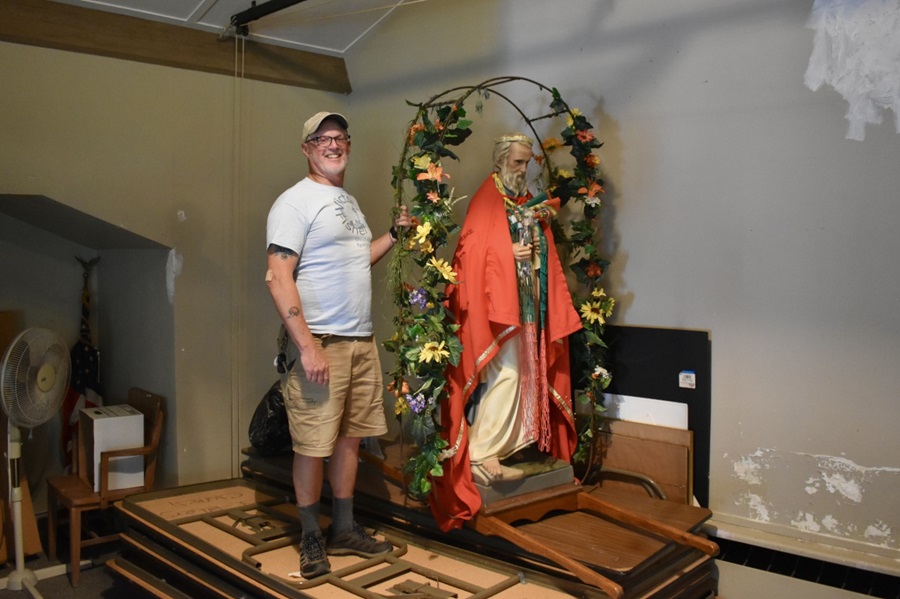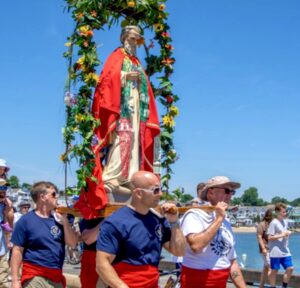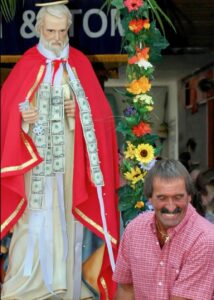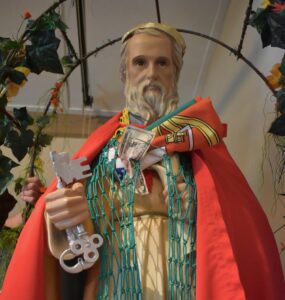PROVINCETOWN — The 28th Provincetown Portuguese Festival begins Friday, June 28 with live music and dancing in Portuguese Square on Ryder Street. During the three-day-long celebration, there will be a fishing derby on MacMillan Pier named for Capt. Kenny Silva, fishermen will tell stories on Ryder Street where there will also be a crafts fair and poetry, and the Knights of Columbus will hold a soup tasting under a tent at the Bas Relief Park behind Provincetown Town Hall. There will be accordions, samba baterias, and fado.
But for at least some people, none of this will compare to the event happening for the 77th time, the Blessing of the Fleet at MacMillan Pier. “Everyone confuses the festival for the blessing,” says Provincetown fisherman Alex Brown. “The festival leads into the blessing, but the blessing is a separate event — it’s always the last Sunday of the month.”

That Sunday starts with a Fishermen’s Mass at St. Peter the Apostle Catholic Church. From there, a group of fishermen (this year, so far, that’s looking like Brown, Christian Costa, and Chris King) carry a statue of St. Peter — the patron saint of netmakers, shipbuilders, and fishermen — down to the pier for the blessing, a ritual meant to ensure a safe and bountiful fishing season.
It’s the week before the blessing and Brown and Nancy Silva just got out of Mass at St. Peter’s. They are backstage in the parish hall standing next to the statue of the saint. Silva grew up in Provincetown. She photographed the festival for years before signing up to help organize in 2019. Now she’s responsible for creating its history-filled booklet. Brown, who wears his company’s gray Victory Fisheries T-shirt and a tan baseball cap, retired from lobstering in 2019 but continues to work his shellfishing grant in Provincetown, which he’s being doing for the last 35 years.
They run through their memories of men who have carried the statue of St. Peter. They can’t agree on which year Chris’s son, Jared, did it and when Brandon Motta carried it.
The church’s St. Peter is six feet tall. He stands under an eight-foot trellis and wears a red robe draped with a green-and-red fishing net with dollar bills tucked into it. “People tuck money into his netting in honor of someone who has passed,” Silva says. Peter grips an elaborate silver key in his enormous, angular right hand and tilts his golden crown downward a touch. He has the slightly possessed gaze of someone on a mission.
“These fishermen — what a dangerous, hard life they had,” says Silva. “They didn’t have GPS, they didn’t have radar — they just went out.” Silva remembers stories of fishermen who went out on schooners, then fished from dories. “Sometimes those dories never came back to that mother ship,” she says. “I grew up here in a fishing family, but we didn’t think of it. Fishing is what you did: you went out to fish and then you had dinner.”
In 1996 a group added the Portuguese Festival to the Blessing of the Fleet. “That’s when everything was beginning to fall apart,” Silva says. “They’d had the blessing since 1947, but the fishing feet was declining.” There had to be another way to recognize the town’s Portuguese fishing heritage.
Brown has been carrying the statue of St. Peter every year since the festival started. He remembers the weight of the original wooden statue. Training was minimal, he says: “Kenny Macara said, ‘OK, kids, your turn.’ ”

The statue weighed over 500 pounds, Brown says. The Portuguese consul came over and tried to lift the statue. When he couldn’t, he promised to bring a lighter statue. “Yes, they stayed with us at the motel in Truro,” says Silva, remembering the whole entourage coming to the Top Mast, her North Truro place.
The new statue, made of polystyrene, is not that much lighter, Brown says. Carrying the saint can be awkward, he adds: “Last year I couldn’t get people and we almost dropped him on the altar.”
“We could put him in a golf cart,” says Silva. “We could decorate it and you could walk alongside it,” she says to Brown.
The original route for carrying the statue from the church to the pier was: “Left out of the church; down Bradford Street; right on Johnson Street past the library; right on Commercial Street; and a left at Lopes Square towards the wharf,” says Brown. “That’s the way we used to do it.”
The route changes from time to time, depending on public works and construction projects and street repairs. The main thing, Brown says, is “trying to avoid going down that hill,” he says.
“So steep,” says Silva.
“Those crosswalks — they’re slippery,” says Brown.
When they get to the corner of the hill they “crab it a little,” Brown says. “I always tell everybody, ‘One step at a time — you don’t want to fall.’ ”
For the last few years, the carriers have taken St. Peter down the Bradford Hill and taken a right on Gosnold Street and a left on Commercial Street to the pier, which will likely be the route this year.
When St. Peter’s Church burned down in January 2005, the Mass before the blessing was held at the marina on Fisherman’s Wharf. “Bobby Cabral owned it at the time,” says Brown. “They set up the church with all the chairs inside Cabral’s big fish house.”
“The Mass that year was one to remember,” says Silva. “Boats were going by; the priests had their backs to the fishing vessels.” Come to think of it, Silva adds, “We should have it there every year. They haven’t done anything with that building yet.”

The marina’s new owners, Chuck and Ann Lagasse, who live in Charlestown, told the Independent in April that the public walkway they promised the town they’d build in 2017 will be ready next spring.
The blessing was at Fisherman’s Wharf for two years. The second year, Brown remembers, it was pouring, and it was windy. Before they set out to carry the saint to the Carol Anne, “I said I’m not putting St. Peter out in this.” There was no procession that year.
“The procession is not just St. Peter — it’s all the families who carry the banners with the names of their fishing vessels,” says Silva.
“The bishop blesses St. Peter and all the banners,” says Brown.
“It’s Bishop da Cunha from the diocese of Fall River. He’s been coming the last five years,” says Silva. “What happens is that St. Peter gets taken to the pier and put on the lead boat for the procession. This year it will be the Glutton, which belongs to Beau and Kathleen Gribbin.” Beau came to the parish hall to measure so he could build a platform on his boat to make St. Peter more visible, Silva says.

“On Chris King’s boat, the Donna Marie, we put him on the pilot house,” says Brown. King, he says, was born in Provincetown and has been fishing since boyhood. He owns Cape Tip Seafood. His father, Capt. William W. King, was lost with his crew of six when the Patricia Marie sank off Eastham in 1976.
“Chris has tried to bring the fishermen back into it more,” says Silva. “So many fishermen are gone. There are a lot of pleasure boats for the blessing, and kayaks now.”
“The draggers don’t want to drive into those people,” says Brown.
Some 100 volunteers work on the festival and coordinate details for the blessing, according to the festival website.
“A lot of these people have spent 25 to 30 years doing this,” says Silva. “The younger people hang the flags. It’s nice to see them involved.” Heather of the Stop & Shop flower dept. makes a crown of flowers for St. Peter and Provincetown’s Michael Lussier attaches it to the arch over the saint. The flowers are donated by Stop & Shop.
“Bishop da Cunha is wonderful; he loves to come for the blessing,” says Silva. “He eats at the Lobster Pot afterwards.”
Editor’s note: An earlier version of this article, published in print on June 27, incorrectly reported that Capt. Kenny Silva would be leading the fishing derby that is named for him. St. Peter’s crown of flowers was made by Heather of the Stop & Stop flower dept., not by Michael Lussier, who attached it to the arch.



